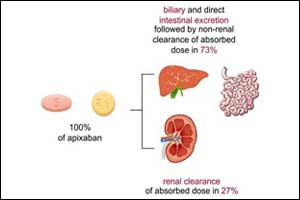- Home
- Editorial
- News
- Practice Guidelines
- Anesthesiology Guidelines
- Cancer Guidelines
- Cardiac Sciences Guidelines
- Critical Care Guidelines
- Dentistry Guidelines
- Dermatology Guidelines
- Diabetes and Endo Guidelines
- Diagnostics Guidelines
- ENT Guidelines
- Featured Practice Guidelines
- Gastroenterology Guidelines
- Geriatrics Guidelines
- Medicine Guidelines
- Nephrology Guidelines
- Neurosciences Guidelines
- Obs and Gynae Guidelines
- Ophthalmology Guidelines
- Orthopaedics Guidelines
- Paediatrics Guidelines
- Psychiatry Guidelines
- Pulmonology Guidelines
- Radiology Guidelines
- Surgery Guidelines
- Urology Guidelines
All about New oral anticoagulant , Apixaban

New oral anticoagulants (NOACs) represent direct-acting drugs functioning selectively for one specific clotting factor. Their clinical indications are the prophylaxis and treatment of deep venous thrombosis and pulmonary embolism, the prevention of atherothrombotic episodes of individuals with acute coronary syndromes and atrial fibrillation (1).
The authors of the article highlight the features of apixaban, which is - as the other NOACs - a convenient drug for it's predictable linear pharmacokinetic and pharmacodynamic properties that provides good bioavailability, is independent of patient sex and age, is an immediate-release form of oral pill with fast dissolution, has a quick onset and offset of action which is useful under the bleeding or surgical conditions, has a short half-life, a relatively wide therapeutic window, and a low number of drug and food interactions without any requirement for the restriction of the diet (1,2,3,4). Moreover, variable dose strengths are available and the effectiveness of the drug is not needed to be monitored, although in some clinical situations it should be considered. Switching patients from low-molecular-weight heparins and vitamin K antagonists to NOACs is also relatively easy. One of the key advantages, in general, are the safety issues with a lower incidence of major bleeding events (1,4,5,6).
For all these advantages, the authors chose to present the complex review of the apixaban´s characteristics including the development of the drug, its pharmacologic properties, and metabolism. They also underlined the need to keep in mind the specific clinical situations in which apixaban should be used with caution, such as hepatic impairment, kidney disease, bleeding symptoms, problems with compliance, extreme body weight, or potential complications derived from the co-administration of apixaban with other drugs (1,4,6).
The authors cordially hope that the review will be interesting for readers of Current Drug Metabolism, especially those working in the field of hemostasis, and provide inspiration for to general researchers for further research in drug metabolism.
For more details click on the link: http://dx.doi.org/10.2174/1389200218666170424151551

Disclaimer: This site is primarily intended for healthcare professionals. Any content/information on this website does not replace the advice of medical and/or health professionals and should not be construed as medical/diagnostic advice/endorsement or prescription. Use of this site is subject to our terms of use, privacy policy, advertisement policy. © 2020 Minerva Medical Treatment Pvt Ltd